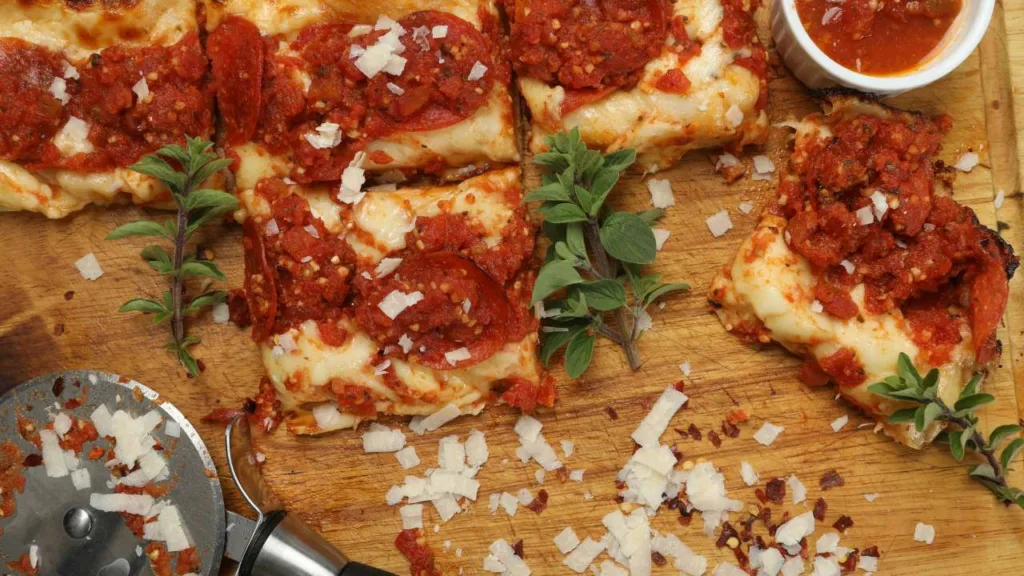Detroit-Style Pizza Recipe
- Luis
- Last Updated on October 31, 2023
Table of Contents
Everyone wants to be able to have their favorite pizza whenever and wherever they want to and with this recipe, you will be able to make authentic Detroit style pizza whenever you desire.
This recipe will teach you all that you need to know about this delicious pizza and after making it for yourself, you will probably never want to do it any other way again and it will definitely be the highlight of your next pizza night.
-
Serves
2 People
-
Cooking Time
15-20 Minutes
-
Preparation Time
4-5 hours
-
Difficulty
Line Cook's Leap
Most people know the order in which pizza toppings are added to a pizza dough, but what about Detroit-style pizza? Well, this is where it gets interesting.
What makes this pizza unique is the fact that the cheese gets added first and the sauce gets added on top of that. Because of this, the cheese around the edges caramelizes beautifully and becomes a perfectly crispy crust.
Detroit-style Pizza Recipe

This Detroit-style pizza has a soft and chewy inside with a crunchy outside which means that this delicious pizza will very quickly become a favorite of yours as well as anyone that tastes it.
Be sure to keep this recipe on hand for the next pizza night with the family and it will surely be the highlight of the week, especially when everyone starts fighting over the corner pieces!
Cooking and Preparation Times
- Cooking time: 15-20 min
- Prep time: 3-4 hours
- Mixing the dough: 30 min
- Rising of the dough: 2-3 hours
- Sauce: 1,5 hours
- Final preparation for baking: 15-30 min
Pizza Dough
Ingredients
- 300g lukewarm water (not boiling, you must be able to touch it without burning)
- 5g instant yeast
- 11g kosher salt
- 28g olive oil (for dough)
- 40g olive oil (extra for the bowl when the dough is rising and to line the pan with)
- 140g semolina flour
- 200g bread flour (for dough)
- 200g bread flour (extra if the dough is too wet and to flour your working surface with)

Method
Measure out all your ingredients beforehand using a scale to ensure accuracy.
In a stand mixer, add the kosher salt at the bottom of a medium-sized bowl, add the flour on top of that, and combine everything thoroughly.
Add the yeast to the bowl and mix it through again. Start adding the water a little at a time and mix it until a shaggy dough forms.
Allow the dough to rest for around 15 min in a covered bowl.
On a low speed, mix the dough with the dough hook attachment for 2-3 min. Mix it on medium speed for an additional 3-5 min until it starts to pull away from the sides of the bowl and the dough is no longer sticking to your hands (add in some of the extra flour a little bit at a time if the mixture is too wet after everything has combined).
In a large bowl, add a quarter of the extra oil and spread it around until the inside of the bowl is evenly covered.
Add the dough to the bowl and cover it with plastic wrap. Allow it to rise for 1-2 hours in a warm place or until the dough has doubled in size.
Add some more olive oil to a classic Detroit pizza pan and ensure that it is evenly coated.
Add your pizza dough to the coated pan and start to dimple the dough as well as stretch it so that it sits evenly in the pan (dimpling traps air in the dough and ensures that it is extra fluffy).
Let the dough rest for around 15 min and repeat the process of dimpling and stretching again to ensure that the dough reaches the edges of the pan.
Cover the dough with plastic wrap or a damp cloth and allow it to rest an additional 30 min.
Switch on the oven halfway through the resting process to 250-260 degrees C (480-500 degrees F) to ensure that it is heated up when your dough is ready to bake.
Toppings
Pizza dough in the pan
Wisconsin brick cheese, grated
Low-moisture mozzarella cheese, shredded
Pepperoni slices (you can use pre-sliced)
Final preparation

Add your shredded cheese on top of the pizza dough and make sure to spread it evenly to the edges of the pan to ensure that the crust will caramelize (don’t be shy with the amount of cheese that you add, you want the crispy crust!).
Spoon sauce over the top of the cheese and follow that with your pepperoni slices.
Bake your pizza for 13-15 min and be sure to keep an eye on it through the whole process.
The pizza will be done baking when the edges become dark and start bubbling. Run a knife around the edges of the pan to loosen the crust and then you can transfer it to a cutting board to slice and serve (ensure that your cutting board is big enough to fit your pizza!).
Recipe Notes
A black metal pan is the best to use for this recipe as it conducts heat better than a normal pan, but it will still work either way. The only difference is that the black metal pan will give you a slightly crispier crust.
If you do not want to use a stand mixer when mixing your dough, you need to ensure that you knead your dough a few minutes longer to get the same result as the stand mixer, but not too long otherwise the dough will become tough.
Any leftover pizza can be stored in the fridge for up to 4 days in a sealed container or even frozen in individual airtight containers or bags for up to 2 months.

Substitutions and additions
If you are running low on something or if you would like to experiment with your pizza and the flavors, this is a little guide to get you started for that process:
Olive oil – Although extra-virgin olive oil adds a fantastic taste to your dough, you are able to substitute this with any neutral flavored oil such as canola oil, vegetable oil, or sunflower oil which would be your best bet.
Pizza sauce – You can use either store-bought or homemade sauce and if you are feeling adventurous and would like to make your own sauce, be sure to check the very end of this article for a fantastic base recipe that you can adjust to your taste.
Cheese – You can cube your hard cheese instead of grating it depending on what your preference is, and you can substitute your low-moisture mozzarella with burrata or even Monterey jack cheese or white muenster. You can also add cheddar cheese to the mix for even more caramelization.
Pepperoni – We all know a pepperoni pizza is absolutely mouth-watering but why not give other proteins like sausage or salami a try? You can even substitute it with something like pickled peppers as well.

Give this recipe a try with your family and have everyone get in on the action when you are making the pizza dough and adding the toppings. This will quickly become a family favorite and will become a regular in the dinner rotations. Be sure to also take a look at this grandma-style pizza recipe for even more fun and a fantastic new recipe to learn.
If you are looking to make your own sauce for your homemade pizza then be sure to take a look at the pizza sauce recipe as well. This is a fantastic sauce to make ahead of time and be sure to take a look at this article on the finer points of this pizza sauce if you want to know how to adjust it and store it for later use.
Disclaimer: Note that the food images displayed on this website are for illustrative purposes only. They are not indicative of the actual dishes or presentations you should expect during the classes. We strive to provide the best culinary experience, but the appearance of dishes may vary. Always refer to class descriptions and details for accurate information on what to expect.
Frequent Asked Questions
What makes a pizza a Detroit pizza?
True Detroit-style pizza is baked in a rectangular pizza pan and has a thick, crisp, and chewy crust. This pan pizza is traditionally topped with mozzarella and/or Wisconsin brick cheese all the way to the edges, which then caramelizes against the high-sided heavyweight rectangular pan.
What cheese to use on Detroit-style pizza?
Authentic Detroit-style pizza uses Wisconsin Brick Cheese which is fatty, creamy, and relatively mild. This cheese melts extremely well and spreads out to coat the whole pizza in a crispy, golden crust.
What kind of flour is used in Detroit pizza dough?
Detroit pizza uses a combination of bread flour and semolina flour. This adds flavor and gives the dough a nice color. The semolina also makes the dough easier to handle.
What's the difference between Chicago-style and Detroit-style pizza?
Detroit-style pizza and Chicago-style pizza bases are both thicker than other thin-crust pizza bases, but their crusts are different from each other.
Chicago-style pizza features a flaky, thin, deep crust and the Detroit-style pizza features a base with a thick, airy crust that is similar to focaccia.
Does sauce goes on top of Detroit-style pizza?
Yes, this pizza does have a sauce that goes on top, but the difference between this pizza and some other ones is the fact that the sauce is the last topping to be added to the pizza instead of the first one.
What kind of pan do you use for Detroit-style pizza?
A Detroit-style pizza pan is a square blue steel pan that gives the pizza crispy edges and the signature shape.
What is the difference between Detroit and New York pizza?
Detroit-style pizza is defined by its crisp crust, those delicious leftover bits of charred cheese, and of course its pudgy size. New York-style pizza, on the other hand, is flat, with a doughy crust, slick with grease, and usually eaten without silverware.
What is the difference between Sicilian and Detroit-style pizza?
Detroit-style pizza is made with Wisconsin brick cheese while Sicilian pizza is made with mozzarella cheese. Detroit-style pizza also has crispy edges and is topped with caramelized cheese, while Sicilian-style pizza has soft edges. Detroit-style pizza is always rectangular, yet Sicilian pizza can be circular or square.


